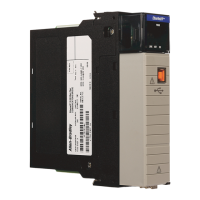Rockwell Automation Publication 1756-UM004D-EN-P - August 2022 21
Chapter 1 ControlLogix EtherNet/IP Network Device Overview
Device Level Ring (DLR) Device Level Ring (DLR) is an EtherNet/IP protocol that is defined by the Open
DeviceNet® Vendors’ Association (ODVA). DLR provides a means to detect,
manage, and recover from single faults in a ring-based network.
A DLR network includes the following types of ring nodes.
Depending on their firmware capabilities, both devices and switches can
operate as supervisors or ring nodes on a DLR network. Only switches can
operate as redundant gateways.
For more information about DLR, see the EtherNet/IP Device Level Ring
Application Technique, publication ENET-AT007
.
Table 5 -
Node Description
Ring supervisor
A ring supervisor provides these functions:
Manages traffic on the DLR network
Collects diagnostic information for the network
A DLR network requires at least one node to be configured as ring supervisor.
By default, the supervisor function is disabled on supervisor-capable devices.
Ring participants
Ring participants provide these functions:
Process data that is transmitted over the network.
Pass on the data to the next node on the network.
Report fault locations to the active ring supervisor.
When a fault occurs on the DLR network, ring participants reconfigure themselves and
relearn the network topology.
Redundant gateways
(optional)
Redundant gateways are multiple switches that are connected to one DLR network and
also connected together through the rest of the network.
Redundant gateways provide DLR network resiliency to the rest of the network.

